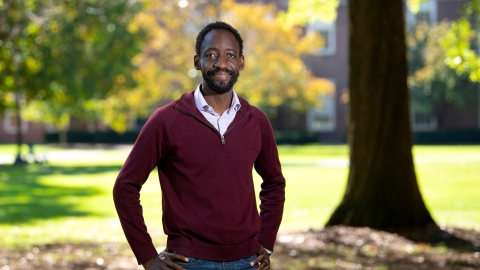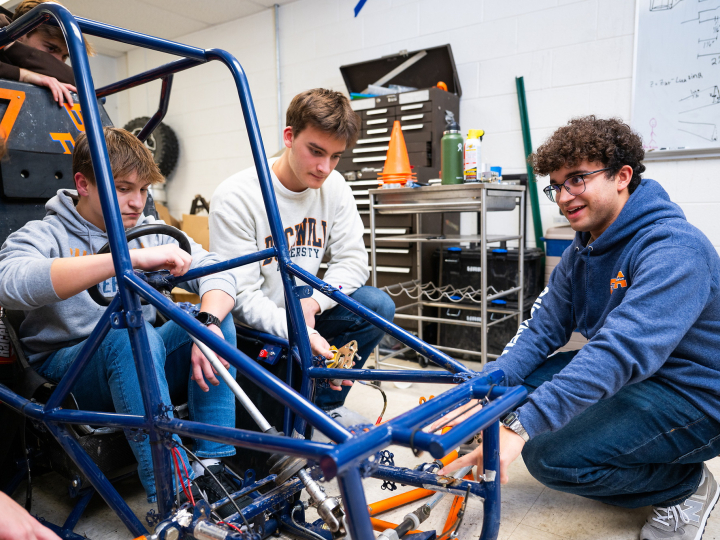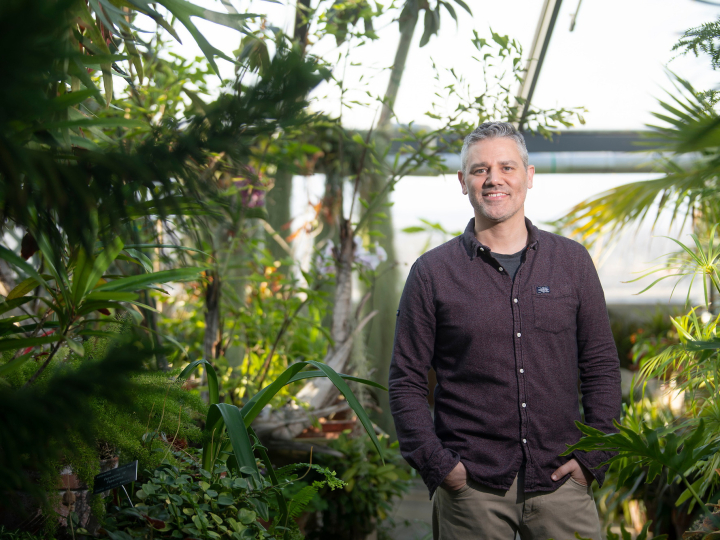
Bucknell Professor, Students Part of NSF Award to Search for Dark Matter
November 5, 2021
Professor Ibrahim Sulai, physics & astronomy, and undergraduate students will be searching for dark matter through atomic magnetometer networks. Photo by Emily Paine, Communications
One of science's big frontiers today is the quest to explain the nature of dark matter — a hypothetical form of matter thought to account for approximately 85% of the matter in the universe. As part of a recent collaborative National Science Foundation Award, Bucknell University Professor Ibrahim Sulai, physics & astronomy, and some of his undergraduate research students will be actively involved in that scientific quest.
The three-year, $245,750 award will provide support for three undergraduate institutions — Bucknell, Oberlin College and California State University, East Bay — to collaborate with the Global Network of Optical Magnetometers to search for Exotic physics (GNOME), a collaboration of 15 institutions around the world that have constructed precision atomic magnetometers capable of detecting or constraining the parameters of certain forms of dark matter. They'll be searching for evidence of hypothetical particles, known as the ultralight bosons, which may be responsible for the universe's dark matter.
"Most scientists believe there is dark matter out there, which for example holds distant stars in orbit," says Sulai, an experimental atomic physicist. "We know it's there, but we don't know its particle nature. That's what we're seeking to illuminate through this project."
The project's principal investigators will work with undergraduate students to develop more sensitive detectors for the network, analyze network data, and collaborate with GNOME institutions worldwide to try to find ultralight bosonic dark matter. In his Bucknell lab, Sulai and a multidisciplinary group of undergraduate students are building highly sensitive atomic magnetometers that sense magnetic fields with very high precision. They hope to build instruments sensitive enough to record atomic fluctuations and contribute to the network's growing scientific dataset.
"In my lab, we're building the next generation atomic magnetometer sensor — really pushing the precision of this kind of measurement," Sulai says. "Colleagues and I in our collaboration all have magnetometers in our labs. If I alone see a fluctuation in the magnetic field signal at Lewisburg, I cannot interpret it as a measurement of ultralight bosons, as it is likely due to some local perturbation, such as an elevator going up and down. But if we see correlated fluctuations in sensors that are separated over vast distances, then that would indicate a source that is not local, such as the bosonic fields that we are searching for."
The Bucknell researchers will use atomic particles found in rubidium, probing the atoms with laser light while shielding them from magnetic noise. They will use GPS to time-stamp their data, which is sent to a central server for analysis. The data from the 15-member magnetometer network are analyzed to look for correlations that would indicate the Earth's passage through invisible dark matter structures or waves.
"There are all sorts of invisible particles and fields surrounding and going through us that we have learned to detect and account for in our physical theories," Sulai says. "In a way, this project is not that different. The goal is to figure out how the dark sector couples with ordinary matter, for that is what will enable detection."
Sulai has been working on the GNOME project since 2017 and the NSF funding will continue to support the work by the Bucknell team. He says three Bucknell students were working on the project last summer, including Ephraim Oliphant '22, a computer science and physics major funded by the Program for Undergraduate Research; Ross Moshier '23, a physics major supported by the Physical Sciences Scholars Program; and Howard Kim '25, a STEM Scholar who is now a first-year computer engineering student at Bucknell.
"I worked on developing an optical cavity, which will be used for characterizing and stabilizing the laser wavelength," Kim says. "I also changed the current and voltage of the laser to find regions of stable operation."
Sulai matches the needs of the project with each student's interest or skill set.
“Our ultimate goals in doing this work are to test different models for dark matter and also to provide meaningful educational experiences to our students — for that is a fundamental part of our mission here,” Sulai says.

